Most everyone has a little trouble getting into a dock from time to time, especially if it is not your “usual” dock and the wind or current conditions might be different than what you are used to.
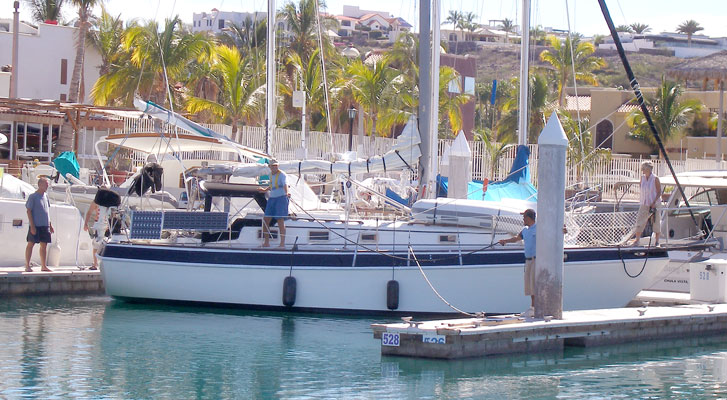
Sailing Mexico and Living It Up!
Once again we spent Thanksgiving in La Paz and joined in on the Club Cruceros celebration. Folks who volunteer to help with the event get to be first in line for the meal, so naturally Bill and Julie pitched in by joining the turkey washing and stuffing party at 7 am in the large kitchen of a local B&B, Casa Buena.

This (9th?) annual event is an outdoor pot-luck dinner for about 250 cruisers and is held at Marina Palmira (where we have been staying). The marina provides tables, chairs, and tenting (bright sunny day, temps in upper 70s). Boaters come from all over town to attend, from the other marinas and even some folks who have “swallowed the anchor” and now live ashore join in.

Cruisers bring a dish to share (coordinated by category of salad, starch, or dessert) and the club provides the turkeys (25) and gravy. Cruisers also pay 40 pesos (about $3.20) a couple or 50 pesos a family to attend and it is BYOB and flatware.
Voyager Trivia
statistics as of 11/19/2011
Since leaving San Francisco on 10/1/2010
We have changed the location of Voyager 102 times.
We have run the engine for 548 hours.
We have consumed apprxoximately 750 gallons of diesel fuel (runs both our engine and generator).
We have covered approximately 3604 miles (a few miles not counted while our knotmeter was offline).
We have spent 212 of 414 nights in marinas (51%).
We have spent 203 of 414 nights at anchor (49%).
We have taken three trips (flights) back to the U.S., about 30 days away from the boat.
We visited one of the “Day of the Dead” gatherings – where Mexican families and friends remember those who have died. This holiday has roots in earlier indigenous celebrations. (Visit one of our favorite websites – wikipedia.org – to learn more)

There is a large cultural center/theatre complex that was the site of a two-day event in La Paz (the first day to remember children, the second day for adults). In addition to several hours of (free) entertainment at a large outdoor stage, there were many elaborately decorated memorials to view, and a variety of food and craft vendors.
The memorial ofrenda (shrines) are commonly decorated with photographs of the deceased being honored, candles, marigolds, skull figures as masks or large sugar candies, plus food/beverage items that the departed enjoyed – such as Pepsi, beer, Tequila. Several Catrinas (costumed females with a skeleton face) walked around the festival and at the end of the evening there was a contest for the best ones in two age categories.
Boats that stay in the water continually have anti-fouling paint applied to the bottom, to retard the growth of marine life. This saves time and effort to clean the boat’s undersides, and helps it to move efficiently through the water. During our 10 years in San Francisco Bay, we could spread out these paint jobs at approximately 3 year intervals. Now that we are in warmer water (things grow faster!), we had to paint the bottom in only two years (one year in cool water, one year in warm water) after our last trip to the boatyard.

For several months we shopped for a boatyard that we would like, both on the Baja peninsula and Pacific mainland. A few weeks ago, we selected the Marina del Palmar (travel_lift@yahoo.com.mx) boatyard in La Paz. This is a nice, family run operation, one of the cleanest boatyards we have been in, with plenty of (efficient and several who are English speaking) staff, and their pricing was competitive. The owner’s 4-5 year-old son had a great time riding his mini gas-powered motorcycle (with training wheels!) throughout the yard and under the boats in the afternoons, cute (we missed getting a photo, use your imagination).
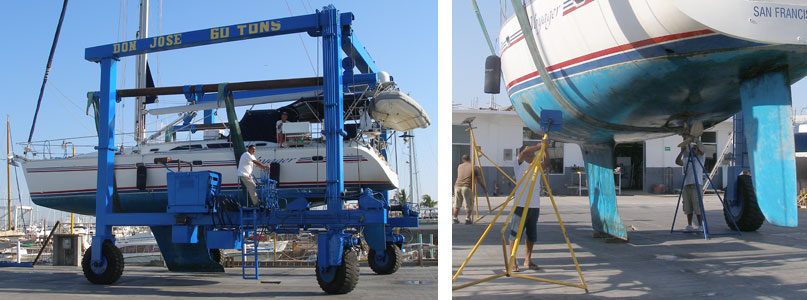
Their 60-ton Travelift, named “Don Jose,” (the machine that moves boats in and out of the water and around the yard), is the perfect size for our boat – other boatyards that have smaller/shorter lifts that require us to remove rigging and equipment (like our satellite antenna and bimini), which is a major pain. The lift was moved into position over our boat, several workers handled the boat lines to get it into position. Two large slings were adjusted and placed under the boat at specific lifting points that are marked on our hull. The boat was raised from the water and rolled over to an open spot in the yard where it was placed on stands for the work to be done. At the end of the process the lift picked the boat up off the stands, and returned it to the water. Bill stayed on the boat when it was hauled from the water, and we both were aboard as the boat was re-floated.

We were able to stay on Voyager overnight while she was in the yard – it is always a good idea to observe the work in progress – even in the U.S. It was a bit inconvenient as we could not run any water (would drain out the bottom of the boat onto our wet paint!), but the marina/yard had restrooms/showers. The weather was still hot (we couldn’t run the air conditioner as it requires water circulating in and out of the boat), so we exited the yard from time to time to seek out a air-conditioned store or restaurant and we could at least run our electric/12v fans.


For those of you boating folks who are reading, there were a few other little projects we accomplished. We removed a dynaplate (formerly helped the transmission/reception of our single-sideband radio) we no longer need and the yard put in a fiberglass patch where it was located, Bill polished the stainless prop and shaft so they looked like new. The yard sanded and applied a barrier coast so that the new bottom paint could cover where our waterline was raised a few inches (the more stuff we put on the boat, the more we hang down into the water). The yard did 98% of the work, but had no problems with a couple of little projects that Bill wanted some “hands on.”

We are back to one of our favorite places (so far) – La Paz. We plan to stay in this area through November…and perhaps longer if the “winter” weather holds off. This page is a collection of miscellaneous images from our summer of exploring the Sea of Cortez.
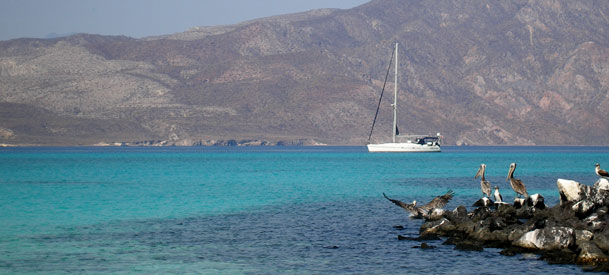
We covered almost 900 miles (162 engine hours) in four months, but left many areas of the Sea (including the eastern coastline) unseen. The sailing fanatics among you will be disappointed that we did not sail more, sometimes there was no wind, sometimes it was in the wrong direction or not enough force to move us at the speed we needed to travel. We still had a great time and enjoyed just about all of the places we visited.
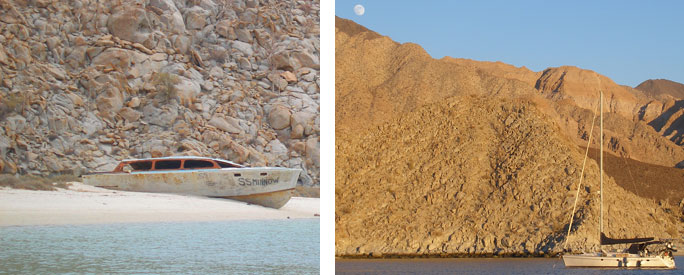
Biggest annoyance besides the heat was “water bees” (if you have fresh water they want to visit you) at some anchorages, they will either cause you to move your boat to another location, or stay down below protected by your (port and hatch) screens.

As we’ve said before the wildlife is very diverse and the fishing ain’t bad either – even if you are rank amateurs as we are. We managed to catch a few dorado (aka mahi-maki), and some other tasty swimmers. Some friends have advocated “fishing with pesos” and we like to support the local fishing industry as well (and its cheaper than losing lures!).

The warm (and often clear) waters were just wonderful for swimming and snorkeling, although we were disappointed with the (lack of) visibility at Bahia de Los Angeles. All those (cloudy) nutrients in the water at B.L.A. must sure be keeping the sea creatures (especially the whales and whale sharks) happy, even if our underwater viewing there was poor to none.
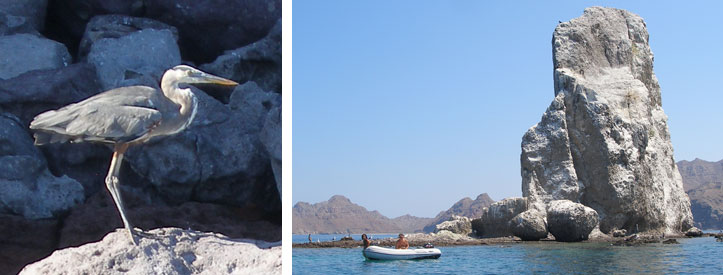
We met some new (to us) cruisers – some who are in their first year in Mexico, others who have been here for a while or longer while! Also we hung out with other friends from San Francisco or who we had met previously either in the Sea or on the mainland coast.
The primitive beauty of this area, the variety of wildlife, the remoteness are very special features of the Sea and should not be missed by any cruising boat traveling this side of Mexico.
This was definitely our hottest summer ever, with many days reaching into the 100s, and not getting below the 80s. We don’t plan to repeat this exact experience next year, although we would consider re-visiting some locations when temps are cooler.
Many do make the mistake of passing this area by in their rush to reach the mainland coast or enroute to the Panama Canal or South Pacific – in spite of that we DID appreciate the many anchorages that we had all to ourselves or shared with just another boat or two.
There are more areas we will continue to explore in the Sea, most likely from Bahia Concepcion south in the coming months.
There are two islands just north of and quite close (couple hours for us) to La Paz – Isla Espiritu Santo and Isla Partida. One of our current favorite spots is the large, three-lobed bay of Ensenade Grande on Partida, we have made several visits to this bay so far.
It’s a roomy anchorage frequented by boats of all sizes and types, from kayaks to small snorkle/scuba charters to large megayachts. When we’ve been in there we’ve observed a slightly higher percentage of power boats versus sail boats. It is a 3-4 hour motoring trip to La Paz for Voyager, faster boats can get there quickly and easily from La Paz – even for just a day trip – which must have something to do with the popularity of this location.

For two nights, one of our closest neighbors was a very lovely, brand-new, 164-foot, (a rare large American-made vessel) motor yacht called Wabi-Sabi. It was not clear if any owner/guests were on board at the time, the crew seemed to be doing some work aboard, pulling all the water toys out of the “garage” at the boat’s stern. (Note to rock fans – we thought this would be a great boat name for “Cabo Wabo” Sammy Hagar – but it’s not his boat.)
The profile of the “shoreline” is very dramatic as you can see. It’s hard to grasp the scale of some of the rocks without someone standing nearby to give you perspective.
There is a fascinating tent “resort” with overnight accomodations set up on one of the beaches. Divers and kayakers can explore the area and then spend the night on the island. The pretty rataan chairs and umbrellas looked particularly inviting.
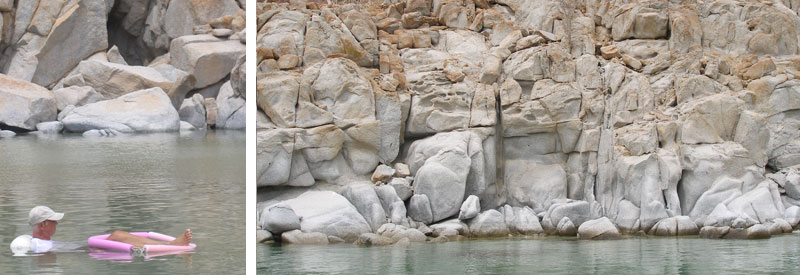
During summers in the upper Sea of Cortez (in part while hiding out from potential hurricanes/tropical storms further south of 27 degrees latitude), there are a series of cruiser gatherings. We joined in on the first one at the La Mona lagoon in Bahia de Los Angeles. About 15 boats were in attendance, plus a few shoreside residents joined in.
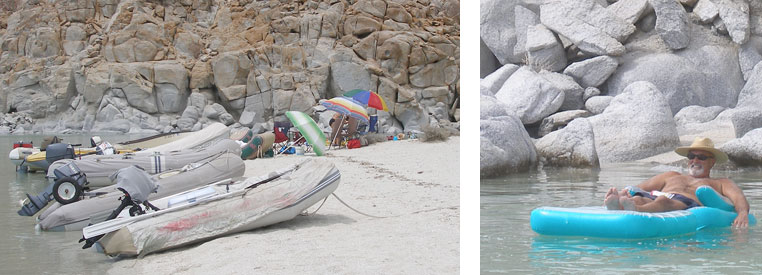
The rock formations in and around this little lagoon are fantastic. There are many varied colors and the appearance changes as the sun moves through the sky from morning to night.
This party was actually two. First an afternoon float-athon in the lagoon. At high tide this little estuary “pool” of water fills in to an average of two feet in depth, then as the tide goes out the “pool” starts to drain giving you a nice leisurely few-minute ride as the water flows out of the lagoon. Exit the bay, walk across a slim finger of sand and hop back into the water to float out again and again. Cold adult beverages were also part of the celebration.
Near sunset, we re-convened at the beach for a potluck, bonfire, moonrise watching, and later a passby above by the International Space Station.
We have made three visits so far to Santa Rosalia. This is a cute town of about 10,000, very non-touristy; it originally grew because of copper mining that has recently resumed after many years of closure. There is a lot of fishing activity here. During our first two visits, fishing pangas (the small ubiquitous boats of Mexico) would exit the marina (a hundred or more) in early evening to catch giant/Humboldt squid. There are three processing plants (Korean & Chinese) in town to prepare this meat for export to Japan. Some boats are still going out in late August, but there seem to be fewer now.
It’s a nice place to stop; we’d recommend it for the scenery, adequate marina facilities and shopping. Folks around town are very friendly, but very little English is spoken compared more touristy areas. A lot of the local architecture has more of a Caribbean feel, many buildings have brightly painted wood walls. The town has two small marinas of about 20 berths each, and one of the rare fuel docks in the mid- & northern Sea of Cortez. We have stayed at the newer Marina Singlar exclusively – they have a small swimming pool, (sometimes) adequate Wi-Fi internet, nice laundry facilities, and it’s a short walk to town relative to other Mexican marinas we have stayed in.

A nickname for the town is El Infierno, as some days reach into the low 100s. Unlike many marinas down here, Singlar includes electricity in the (reasonable) slip rental price so we are enjoying running our air conditioners 24-7. We’re very happy to have added A/C to the boat a few years before we left CA (we often used the “heat” mode in the Bay Area), quite a few boaters down here don’t have it. We were docked next to some folks who have been down here four years on their sailboat (from WA) with their lovely kitty and no A/C. I suppose she must be acclimated by now but the cat loses weight over the summer and they have to make sure to always encourage her to drink lots of water.
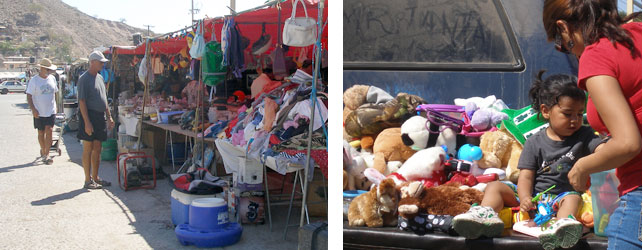
We do our shopping/errands in town early in the morning when it is cooler. There are several decent grocery stores and produce stands here (but nothing one would call a supermarket). This town is right off a main highway (#1) so they get regular deliveries from parts north and south. The town is also a ferry port (50 yards from our dock) that goes back and forth from S.R. to Guymas on the mainland coast. We have recently been enjoying some nice stone fruits from Central California. Obtaining quality meat items is easy here (albeit mostly frozen) – we had some great burgers the other night. Ordinary staple items are abundant; I even saw sushi rice available in a couple of stores and various Kirkland (Costco) items show up in small shops.

On our first visit we were docked next to a couple from Southern California who we had originally met back in March in Manzanillo/Las Hadas. They have been driving their car back and forth down here over the summer and were kind enough to collect a few needed West Marine items for us (plus a couple bottles of California Sauvignon Blanc and Torani sugar-free vanilla coffee syrup, the latest New Yorker and Economist) during one of their trips back to the U.S., what a treat! Then, some other friends drove down with other goodies (including more fans!) about a month later. It’s just like Christmas when this stuff shows up! There ARE several items one cannot find up here so we keep a running list of items to locate when we return to La Paz/chain store land of Wal-Mart (cheap Argentinean & Chilean wine), Home Depot (5 gallon bucket) – there are several hardware stores in town but no joy in this department, Office Max, Auto Zone, etc.
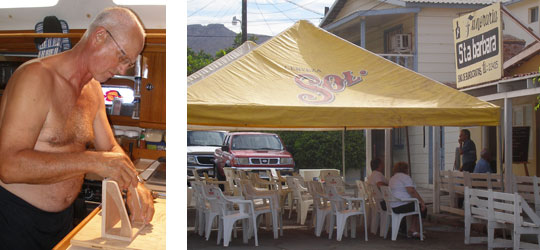
There’s a nice little coffee shop (no Starbucks, no chains around here!), and the eating places are laid back and economical (right up our alley). Several street vendors have great fish and shrimp tacos, empanadas, and the locally famous “deep fried bacon-wrapped” hot dogs, yum!
A few nights ago we finally encountered our first real rain since leaving CA last October. There was a squall that went through here late at night (winds up to 25-30 knots) with some lighting and thunder, and the rain came down good for at least a half hour. We were able to look at a radar (Doppler?) image online and this particular storm reached all the way down to the Mazatlan area (300 miles?). What was nice (besides being securely tied to a dock during this event!) is that we got a good wash for our mast and rigging (the deck had quite a bit of dirt on it the following morning that had run down from above).

Bill had a birthday during our first stay in S.R. The night before, six of us visited a waterfront seafood restaurant and finished off the evening with ice cream bars. Daughter/crew Pari from (2010 Baja Ha-Ha boat) Safety Cat had her seventh birthday simultaneous to Bill’s, so about of a dozen of us cruisers celebrated poolside at the marina (Pari’s mom Andrea even made a cake).
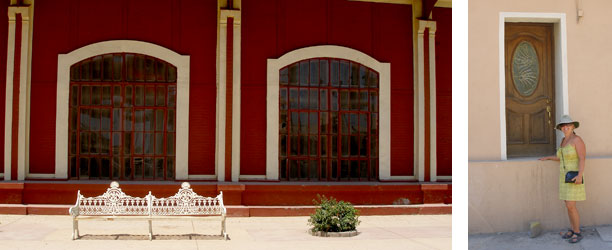
Two other sailboats/couples we know from the San Francisco area (who were also on the 2010 Baja Ha-ha rally with us) are right down the dock from us so we have been catching up with them. We’ll stay here ‘til approximately 9/1 when we will take 2-3 weeks to head back south the approximately 200 miles to La Paz, making several stops along the way…we missed many places on our way north in June.
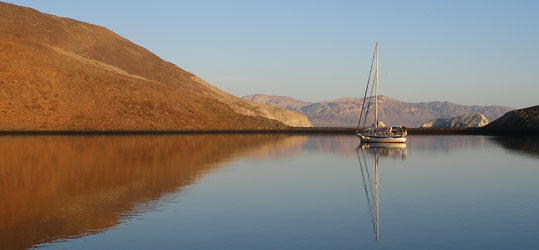
Another favorite anchorage in B.L.A. was Don Juan, an almost fully enclosed bay. It occasionally is used as a “hurricane hole” as it’s quite protected from wind and waves. It’s roughly pear shape (perhaps 1×2 miles in size) with the entrance would be at the “stem” end. There’s one small area of the bay called the “window,” a margin of land only a few feet above the water level at low tide, which lets some breeze in to keep the air a bit cooler.
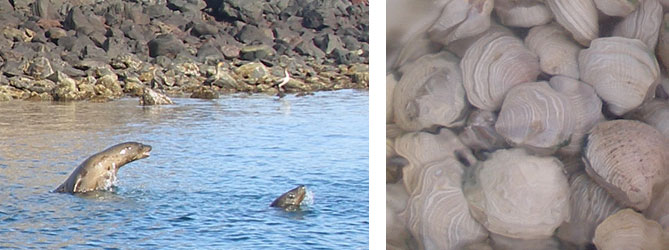
Lots of sea mammals in the area. Several times we went out in our dinghy so dolphins could play chase with us (they seem to love it). Also plenty of pelicans, terns, blue footed boobies, seagulls, cormorants, and other sea birds. Various stingrays like to jump/fly out of the water (don’t know why) and they make a great belly-flopping, slapping sound when they land. Coyotes howled on the beaches some nights, we even saw a few roaming along the shoreline during the day.

A few times we were the only boat in this anchorage, so we of course had to try out some clothing-optional swims (sorry, no photos available)! At most there were 3-4 other boats around us, with ample room for at least 12-15 boats to anchor. Some days it was just us and our “sister” boat Firefly.

We basically moved the boat around every few days between La Mona, Don Juan and the village for the better part of a month. While at anchor we were swimming, reading, playing in the dinghy (we bought a towable floatie when we were last in La Paz), just generally goofing off. If other boats were around us we’d frequently do a pot luck or happy hour late in the day. We have lots of movies and TV shows on hard drives so when it is cooler down inside the boat we would vegetate in front of the tube.
